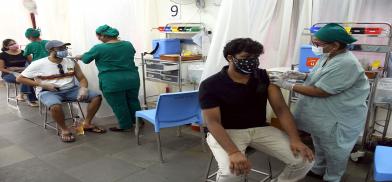Vaccination in South Asia: India still remains the best hope
While India must resume supplies to its neighbors, there is much that it can also learn from some of their best practices, including Bhutan, writes N Chandra Mohan for South Asia Monitor

There is no doubt that a faster roll-out of vaccines will help fight the raging COVID-19 pandemic that has afflicted 157 million-plus people globally. Unfortunately, access to vaccinations is iniquitous. At a time when 646 million people have received at least one jab, most of it is in the advanced countries. Of this, 12.9 million or two percent are from Bangladesh, Bhutan, Maldives, Nepal, Pakistan and Sri Lanka.
Less than one percent of Africans have received a single dose. The pandemic has taken a heavy toll in South Asia with over 24 million confirmed cases and 273, 326 lost their lives till the first week of May, according to Our World in Data.
Improving vaccine supply
The big question is whether vaccine availability will improve with the support of 60-odd countries, including the US, to India and South Africa’s proposal at the World Trade Organization for a waiver of intellectual property rights protection for essential COVID-19 medicines. Big pharma naturally is opposed to any temporary waiver as it will discourage innovation and reduce their profits. But even if WTO accedes to this proposal, it is unlikely that vaccine production can be swiftly ramped up like the cheaper generic versions of AIDS medication more than two decades ago which forced big pharma to drastically slash prices.
Vaccines take a lot more time to produce, considering the limited manufacturing facilities in the developing world and global supply chain issues. The Pfizer vaccine, for instance, entails 280 components from 86 suppliers in 19 countries. Even with a patent waiver, immediately scaling up production of this mRNA vaccine is not feasible in the short run. It bears mention that supply chain issues in the form of a US ban on the export of 37 critical items including bags and filters under the Defense Production Act bedeviled the plans of the Pune-based USD 804 million Serum Institute of India, the largest low-cost producer of vaccines globally.
Instead of resisting a waiver, big pharma can respond to this pandemic with licensing agreements to vaccine manufacturers in India and South Africa. To be sure, this has already happened. Pfizer’s mRNA technology owned by the German BioNTech has been licensed to Fosun Pharma to make vaccines in China. By the way, Fosun has a presence in India after taking over Gland Pharma four years ago.
Big pharma can thus help in delivering low-cost vaccines through COVAX, the vaccines pillar of the Access to COVID-19 Tools Accelerator, co-led by the Coalition for Epidemic Preparedness Innovations, GAVI
and the World Health Organisation.
India hope for South Asia
For South Asia, the best hope on the vaccine front is India sorting out its supply-side issues on production. Despite having a head start, the country dithered on providing timely advance orders to SII and Bharat Biotech to scale up their production. Serious shortages thus have developed when the virus is surging and the need is to vaccinate all those above 18 years of age.
With other vaccines also likely to enter the market like Russia’s Sputnik, there is soon bound to be a situation of potential plenty to inoculate India's domestic population and also minister to the needs of the South Asian neighborhood and global poor.
India has so far supplied 66 million doses to 95-odd countries through outright grants, commercially or through COVAX. The neighborhood received 24 percent of this, with Afghanistan receiving 968,000 doses, Bangladesh (10.3 million), Sri Lanka (1.3 million). Maldives (312,000), Bhutan (550,000) according to the Indian Ministry of External Affairs. Some of these neighbors have effectively utilized this supply in covering more of their population.
The Maldives thus has administered 79 vaccine doses per 100 people. In Bhutan, it is 62.35 per 100 people while in India it is much less at 11.78 doses administered per 100 people.
Lessons from neighborhood
While India must resume supplies to its neighbors, there is much that it can also learn from some of their best practices. Emulating Bhutan’s success in partially vaccinating 62.35 percent of its population through community participation is a case in point. It did this despite beginning late on March 27. The Himalayan kingdom utilized this delay by registering all those to be vaccinated. King Jigme Khesar Namgyel Wangchuk formed a national service corps, called the Guardians of Peace, that helped set up 1,200 vaccination centers. These volunteers delivered vaccines to these centers and ensured the citizenry showed up, according to the Indian Express.
South Asia, for its part, also needs to beef up its health care infrastructure. Vaccinations can take off with better cold chain facilities. The number of health professionals – doctors, nurses and midwives -- is low relative to the population. The delivery systems need to improve if vaccines are to save lives and livelihoods and ensure that the region remains an engine of global growth.
(The writer is an economics and business commentator based in New Delhi. Views are personal. He can be contacted on nchandramohan@rediffmail.com)











Post a Comment